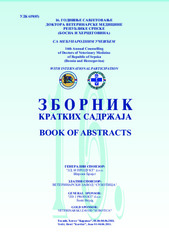Приказ основних података о документу
Napredak u veterinarskoj regenerativnoj medicini: mogućnost korišćenja biomaterijala na bazi kalcijum fosfata na eksperimentalnom modelu pacova
The improvement in veterinary regenerative medicine: the posibillity of using the biomaterials based on calciumphosphates on rat experimental model
| dc.creator | Marković, Danica | |
| dc.creator | Kojić, Zvezdana | |
| dc.creator | Kovačević Filipović, Milica | |
| dc.creator | Radovanović, Anita | |
| dc.creator | Andrić, Nenad | |
| dc.creator | Francuski, Jelena | |
| dc.creator | Todorović, Vera | |
| dc.date.accessioned | 2024-01-31T11:20:30Z | |
| dc.date.available | 2024-01-31T11:20:30Z | |
| dc.date.issued | 2011 | |
| dc.identifier.isbn | 978-99938-729-8-6 | |
| dc.identifier.uri | https://vet-erinar.vet.bg.ac.rs/handle/123456789/3605 | |
| dc.description.abstract | Regenerative medicine is the field of human and veterinary medicine that involves creating living, functional tissue to repair and replace tissues or organs that have been damaged by injury, disease, aging or birth defects. Regenerative adult cell therapy with or without supporting biocompatible material, has been currently successfully treated in horses and dogs, especially in joint, bone and ligament injuries. The aim of this study was to evaluate the biocompatibility of three different bioceramical materials (BCM) implanted (paravertebral lumbal region) in rat subcutaneous tissue according to the International standard procedures (ISO 10993-6; ISO 10993-10) for screening tests by histological examinations. In order for biocompatibility phenomena to be investigated and to choose of an implantable device we use the routine histological techniques (H&E, TB, AZAN), immunohistochemical method (for labeling T and B lymphocytes and macrophages) and scanning electron microscopic investigations on interface of biomaterials. Thirty two rats were assigned to 4 groups, as following: control group; dental ceramic (DC) implants; alfa tricalcium phosphate (áTCP); hydroxyapatite (HAP). The irritation index (the level of tissue injuring) was noted microscopically and tabelar system of evaluations were compared in grading scores from 0 to 4, where results had been described from mild (1) to severe (4). The inflammatory infiltrate consisted of lymphocytes, polimorphonuclears, macrophages, siderophages and mastocytes. At the same time there were sign of encapsulation and neovasculogenesis around BCM. In conclusion, the irritation index among the different BCM were in all cases in the range of biocompatibility. Evaluating different responses according to BCM, the most intense tissue reaction was noticed at HAP, grading as severe and mild to moderate for DC and áTCP. | sr |
| dc.language.iso | sr | sr |
| dc.language.iso | en | sr |
| dc.publisher | Banja Luka : Veterinarska komora Republike Srpske | sr |
| dc.rights | openAccess | sr |
| dc.rights.uri | https://creativecommons.org/licenses/by/4.0/ | |
| dc.source | 16. Godišnje savjetovanje doktora veterinarske medicine Republike Srpske (Bosan i Hercegovina) sa međunarodnim učešćem, Teslić, 1 - 4. jun 2011 | sr |
| dc.subject | Regenerative medicine | sr |
| dc.subject | bioceramics | sr |
| dc.subject | biocompatibility | sr |
| dc.subject | histology | sr |
| dc.title | Napredak u veterinarskoj regenerativnoj medicini: mogućnost korišćenja biomaterijala na bazi kalcijum fosfata na eksperimentalnom modelu pacova | sr |
| dc.title | The improvement in veterinary regenerative medicine: the posibillity of using the biomaterials based on calciumphosphates on rat experimental model | sr |
| dc.type | conferenceObject | sr |
| dc.rights.license | BY | sr |
| dc.citation.spage | 70 | |
| dc.citation.epage | 71 | |
| dc.description.other | Zbornik kratkih sadržaja | sr |
| dc.identifier.fulltext | http://veterinar.vet.bg.ac.rs/bitstream/id/10786/bitstream_10786.pdf | |
| dc.identifier.rcub | https://hdl.handle.net/21.15107/rcub_veterinar_3605 | |
| dc.type.version | publishedVersion | sr |

